cooling LINCOLN MKS 2012 Owners Manual
[x] Cancel search | Manufacturer: LINCOLN, Model Year: 2012, Model line: MKS, Model: LINCOLN MKS 2012Pages: 384, PDF Size: 2.49 MB
Page 50 of 384
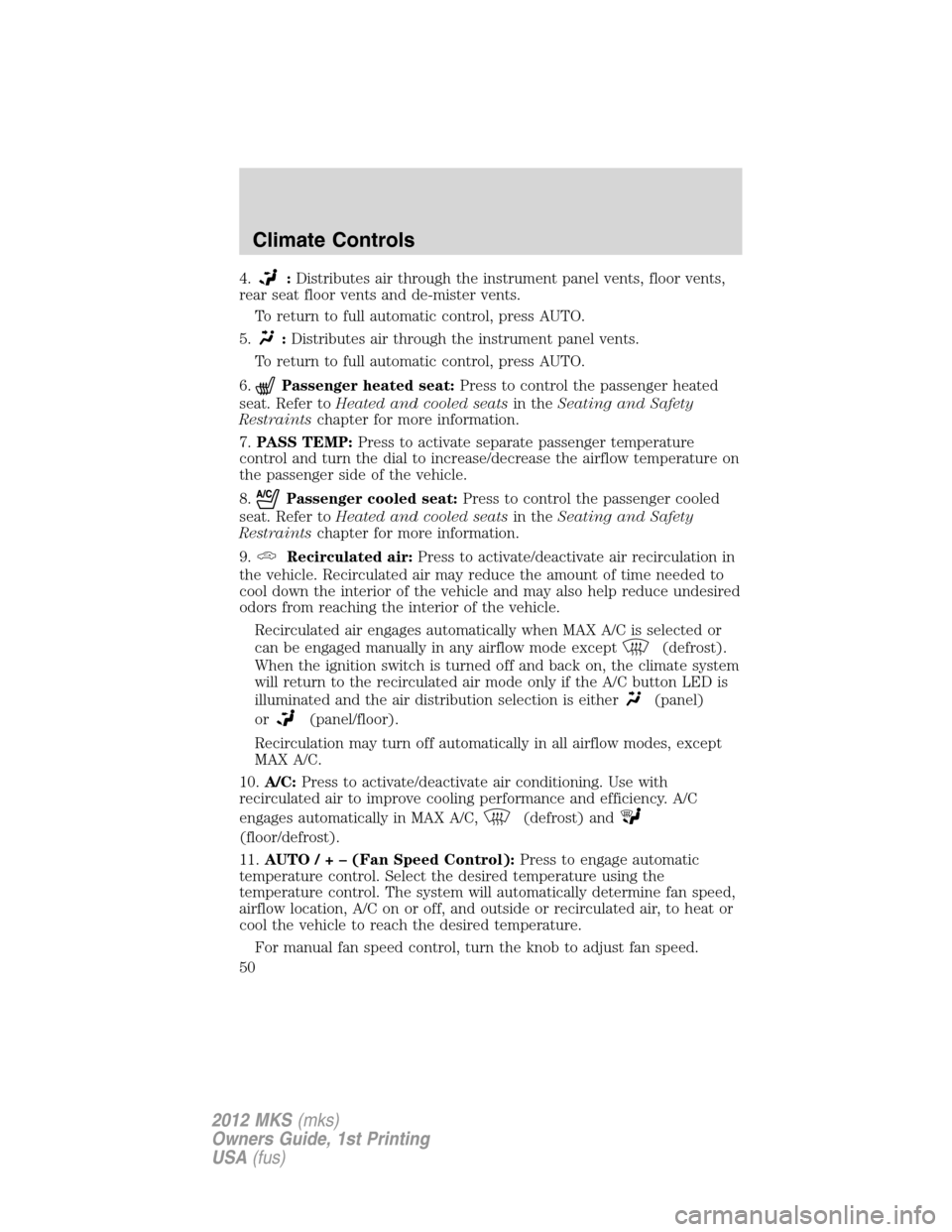
4.:Distributes air through the instrument panel vents, floor vents,
rear seat floor vents and de-mister vents.
To return to full automatic control, press AUTO.
5.
:Distributes air through the instrument panel vents.
To return to full automatic control, press AUTO.
6.
Passenger heated seat:Press to control the passenger heated
seat. Refer toHeated and cooled seatsin theSeating and Safety
Restraintschapter for more information.
7.PASS TEMP:Press to activate separate passenger temperature
control and turn the dial to increase/decrease the airflow temperature on
the passenger side of the vehicle.
8.
Passenger cooled seat:Press to control the passenger cooled
seat. Refer toHeated and cooled seatsin theSeating and Safety
Restraintschapter for more information.
9.
Recirculated air:Press to activate/deactivate air recirculation in
the vehicle. Recirculated air may reduce the amount of time needed to
cool down the interior of the vehicle and may also help reduce undesired
odors from reaching the interior of the vehicle.
Recirculated air engages automatically when MAX A/C is selected or
can be engaged manually in any airflow mode except
(defrost).
When the ignition switch is turned off and back on, the climate system
will return to the recirculated air mode only if the A/C button LED is
illuminated and the air distribution selection is either
(panel)
or
(panel/floor).
Recirculation may turn off automatically in all airflow modes, except
MAX A/C.
10.A/C:Press to activate/deactivate air conditioning. Use with
recirculated air to improve cooling performance and efficiency. A/C
engages automatically in MAX A/C,
(defrost) and
(floor/defrost).
11.AUTO/ + – (Fan Speed Control):Press to engage automatic
temperature control. Select the desired temperature using the
temperature control. The system will automatically determine fan speed,
airflow location, A/C on or off, and outside or recirculated air, to heat or
cool the vehicle to reach the desired temperature.
For manual fan speed control, turn the knob to adjust fan speed.
Climate Controls
50
2012 MKS(mks)
Owners Guide, 1st Printing
USA(fus)
Page 51 of 384
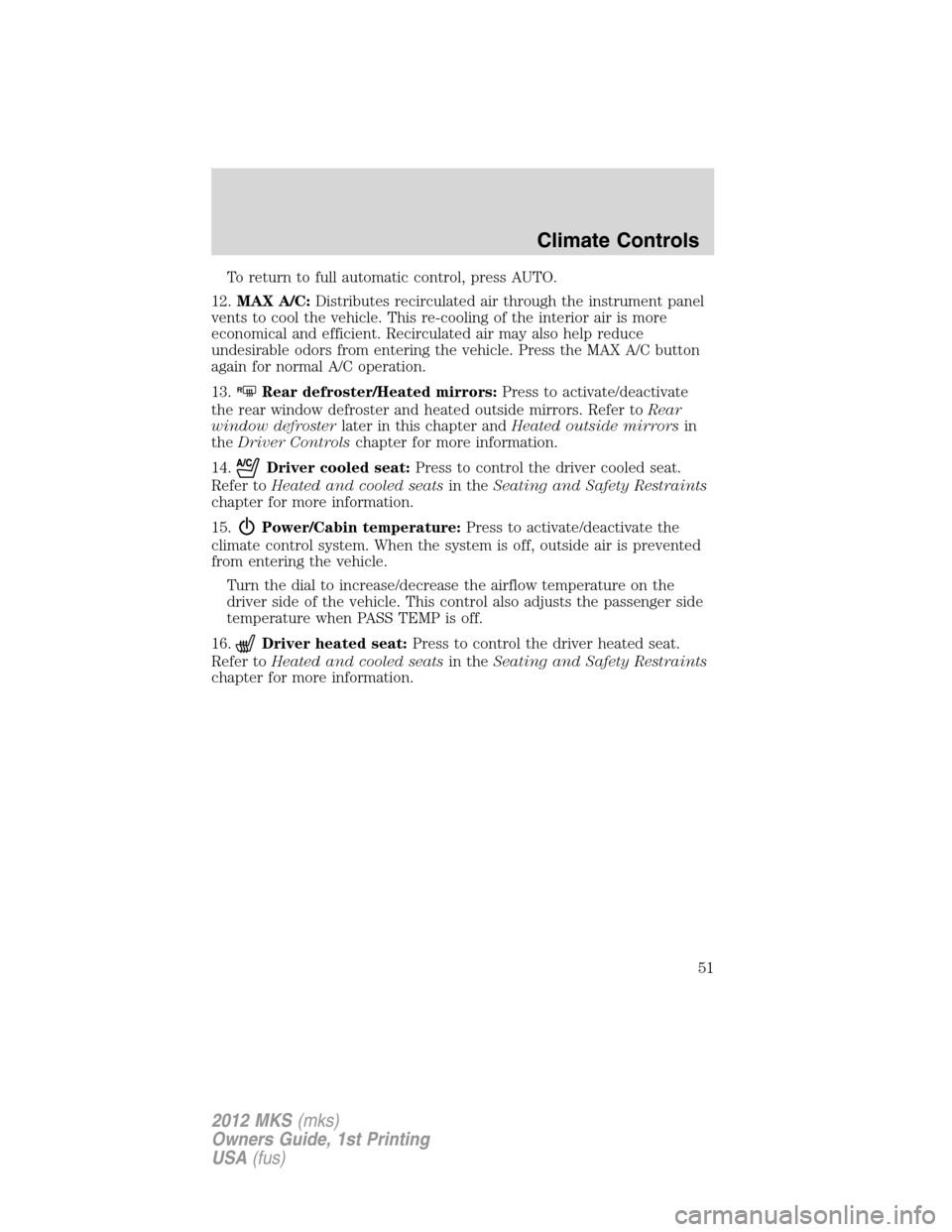
To return to full automatic control, press AUTO.
12.MAX A/C:Distributes recirculated air through the instrument panel
vents to cool the vehicle. This re-cooling of the interior air is more
economical and efficient. Recirculated air may also help reduce
undesirable odors from entering the vehicle. Press the MAX A/C button
again for normal A/C operation.
13.
RRear defroster/Heated mirrors:Press to activate/deactivate
the rear window defroster and heated outside mirrors. Refer toRear
window defrosterlater in this chapter andHeated outside mirrorsin
theDriver Controlschapter for more information.
14.
Driver cooled seat:Press to control the driver cooled seat.
Refer toHeated and cooled seatsin theSeating and Safety Restraints
chapter for more information.
15.
Power/Cabin temperature:Press to activate/deactivate the
climate control system. When the system is off, outside air is prevented
from entering the vehicle.
Turn the dial to increase/decrease the airflow temperature on the
driver side of the vehicle. This control also adjusts the passenger side
temperature when PASS TEMP is off.
16.
Driver heated seat:Press to control the driver heated seat.
Refer toHeated and cooled seatsin theSeating and Safety Restraints
chapter for more information.
Climate Controls
51
2012 MKS(mks)
Owners Guide, 1st Printing
USA(fus)
Page 52 of 384
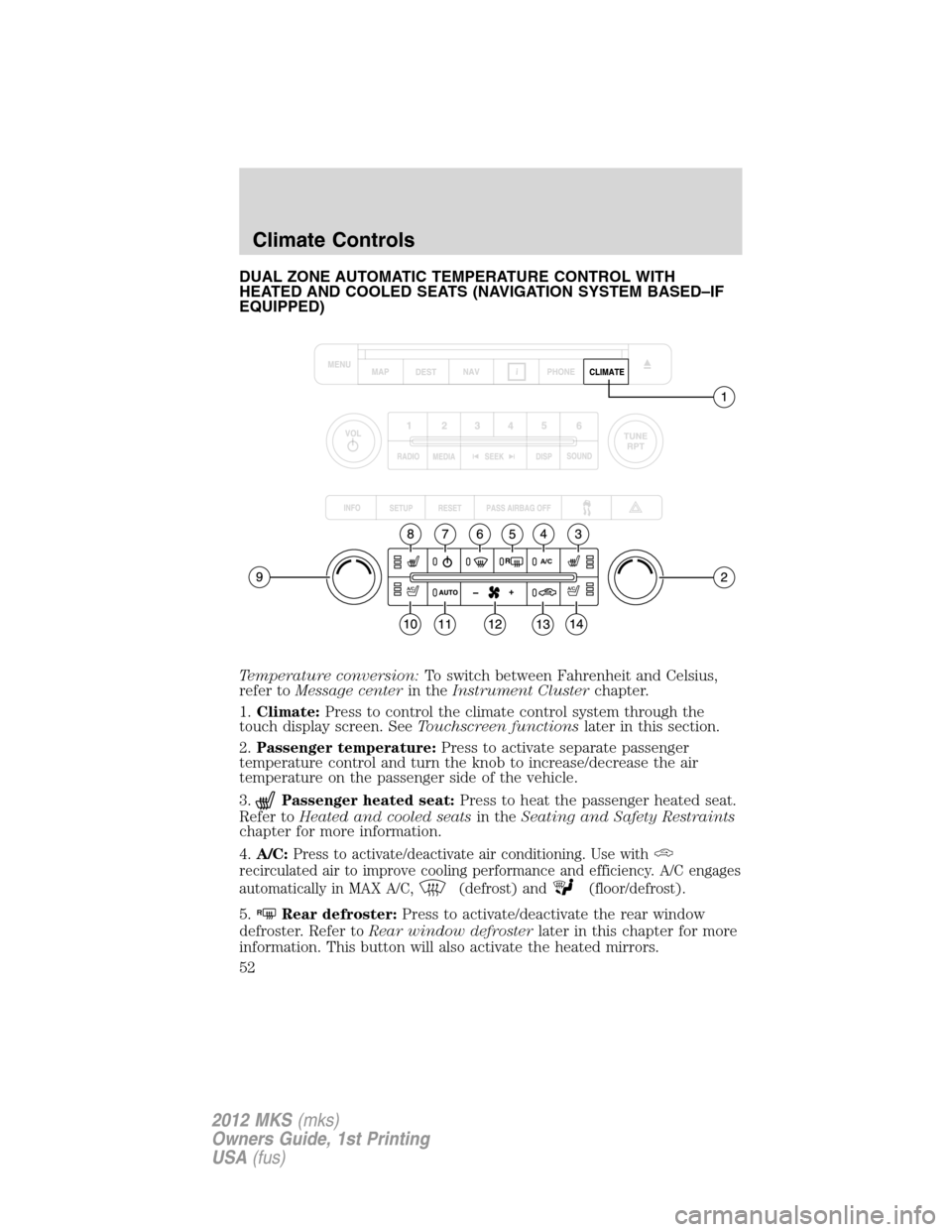
DUAL ZONE AUTOMATIC TEMPERATURE CONTROL WITH
HEATED AND COOLED SEATS (NAVIGATION SYSTEM BASED–IF
EQUIPPED)
Temperature conversion:To switch between Fahrenheit and Celsius,
refer toMessage centerin theInstrument Clusterchapter.
1.Climate:Press to control the climate control system through the
touch display screen. SeeTouchscreen functionslater in this section.
2.Passenger temperature:Press to activate separate passenger
temperature control and turn the knob to increase/decrease the air
temperature on the passenger side of the vehicle.
3.
Passenger heated seat:Press to heat the passenger heated seat.
Refer toHeated and cooled seatsin theSeating and Safety Restraints
chapter for more information.
4.A/C:
Press to activate/deactivate air conditioning. Use with
recirculated air to improve cooling performance and efficiency. A/C engages
automatically in MAX A/C,
(defrost) and(floor/defrost).
5.RRear defroster:Press to activate/deactivate the rear window
defroster. Refer toRear window defrosterlater in this chapter for more
information. This button will also activate the heated mirrors.
A/C
Climate Controls
52
2012 MKS(mks)
Owners Guide, 1st Printing
USA(fus)
Page 54 of 384
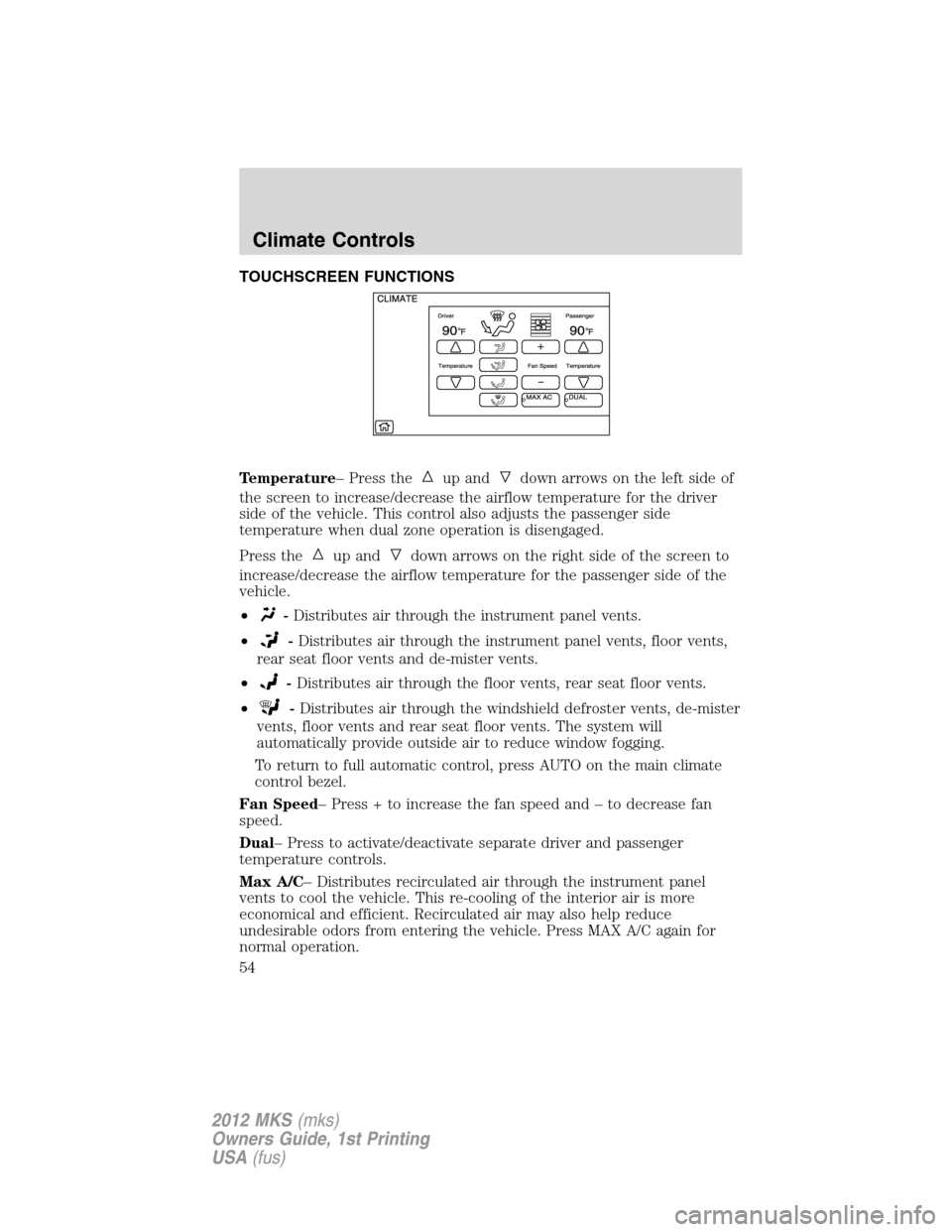
TOUCHSCREEN FUNCTIONS
Temperature– Press the
up anddown arrows on the left side of
the screen to increase/decrease the airflow temperature for the driver
side of the vehicle. This control also adjusts the passenger side
temperature when dual zone operation is disengaged.
Press the
up anddown arrows on the right side of the screen to
increase/decrease the airflow temperature for the passenger side of the
vehicle.
•
-Distributes air through the instrument panel vents.
•
-Distributes air through the instrument panel vents, floor vents,
rear seat floor vents and de-mister vents.
•
-Distributes air through the floor vents, rear seat floor vents.
•
-Distributes air through the windshield defroster vents, de-mister
vents, floor vents and rear seat floor vents. The system will
automatically provide outside air to reduce window fogging.
To return to full automatic control, press AUTO on the main climate
control bezel.
Fan Speed– Press + to increase the fan speed and – to decrease fan
speed.
Dual– Press to activate/deactivate separate driver and passenger
temperature controls.
Max A/C– Distributes recirculated air through the instrument panel
vents to cool the vehicle. This re-cooling of the interior air is more
economical and efficient. Recirculated air may also help reduce
undesirable odors from entering the vehicle. Press MAX A/C again for
normal operation.
Climate Controls
54
2012 MKS(mks)
Owners Guide, 1st Printing
USA(fus)
Page 55 of 384
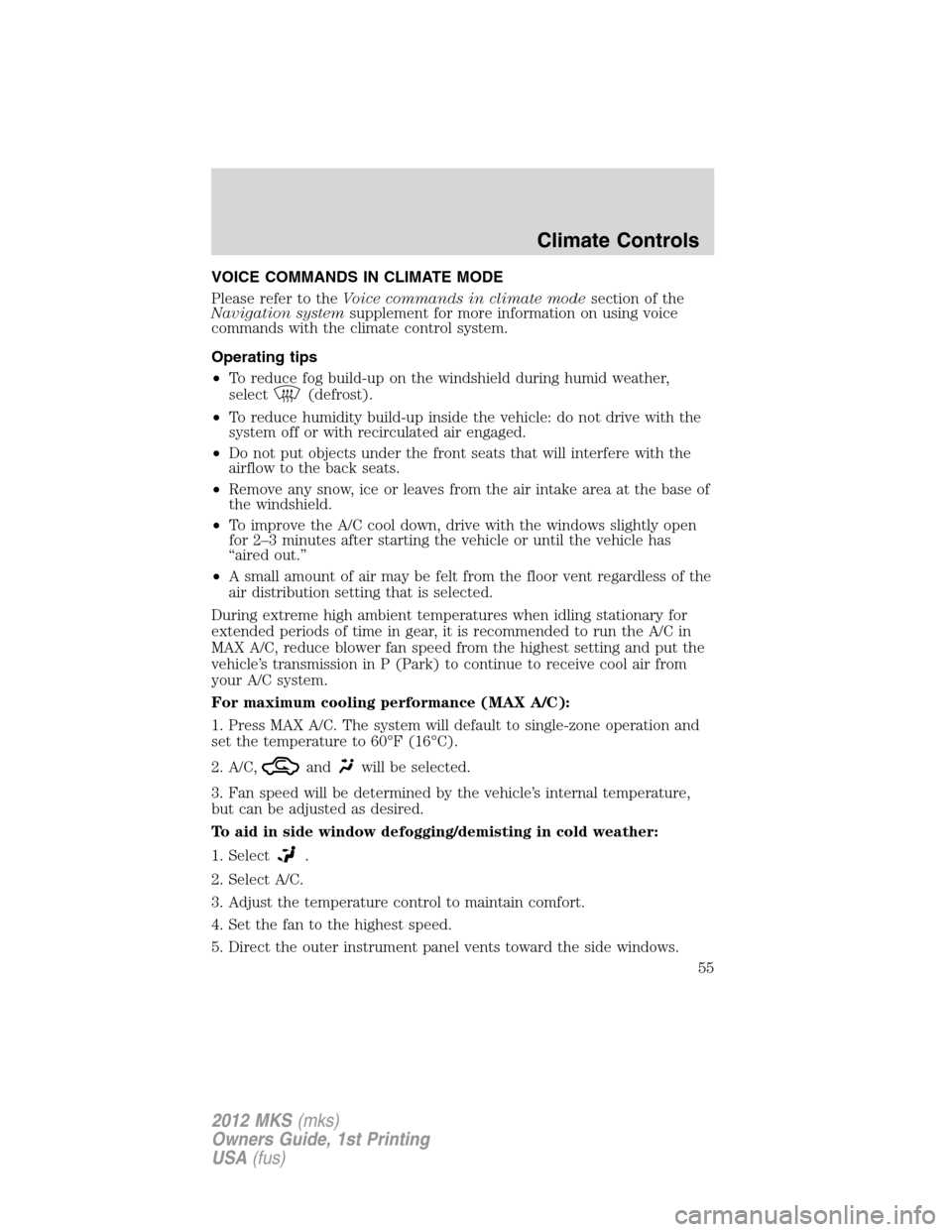
VOICE COMMANDS IN CLIMATE MODE
Please refer to theVoice commands in climate modesection of the
Navigation systemsupplement for more information on using voice
commands with the climate control system.
Operating tips
•To reduce fog build-up on the windshield during humid weather,
select
(defrost).
•To reduce humidity build-up inside the vehicle: do not drive with the
system off or with recirculated air engaged.
•Do not put objects under the front seats that will interfere with the
airflow to the back seats.
•Remove any snow, ice or leaves from the air intake area at the base of
the windshield.
•To improve the A/C cool down, drive with the windows slightly open
for 2–3 minutes after starting the vehicle or until the vehicle has
“aired out.”
•A small amount of air may be felt from the floor vent regardless of the
air distribution setting that is selected.
During extreme high ambient temperatures when idling stationary for
extended periods of time in gear, it is recommended to run the A/C in
MAX A/C, reduce blower fan speed from the highest setting and put the
vehicle’s transmission in P (Park) to continue to receive cool air from
your A/C system.
For maximum cooling performance (MAX A/C):
1. Press MAX A/C. The system will default to single-zone operation and
set the temperature to 60°F (16°C).
2. A/C,
andwill be selected.
3. Fan speed will be determined by the vehicle’s internal temperature,
but can be adjusted as desired.
To aid in side window defogging/demisting in cold weather:
1. Select
.
2. Select A/C.
3. Adjust the temperature control to maintain comfort.
4. Set the fan to the highest speed.
5. Direct the outer instrument panel vents toward the side windows.
Climate Controls
55
2012 MKS(mks)
Owners Guide, 1st Printing
USA(fus)
Page 134 of 384
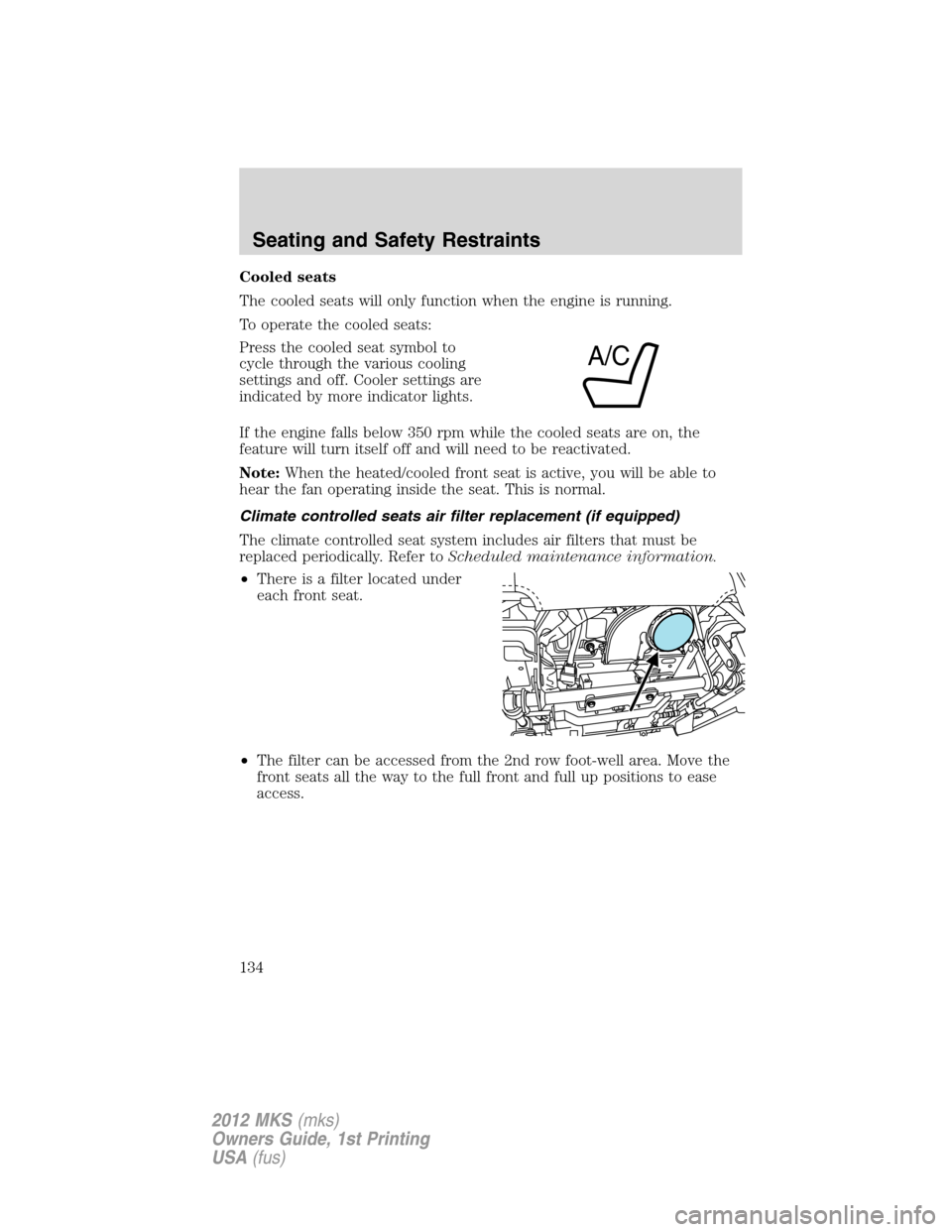
Cooled seats
The cooled seats will only function when the engine is running.
To operate the cooled seats:
Press the cooled seat symbol to
cycle through the various cooling
settings and off. Cooler settings are
indicated by more indicator lights.
If the engine falls below 350 rpm while the cooled seats are on, the
feature will turn itself off and will need to be reactivated.
Note:When the heated/cooled front seat is active, you will be able to
hear the fan operating inside the seat. This is normal.
Climate controlled seats air filter replacement (if equipped)
The climate controlled seat system includes air filters that must be
replaced periodically. Refer toScheduled maintenance information.
•There is a filter located under
each front seat.
•The filter can be accessed from the 2nd row foot-well area. Move the
front seats all the way to the full front and full up positions to ease
access.
A/C
Seating and Safety Restraints
134
2012 MKS(mks)
Owners Guide, 1st Printing
USA(fus)
Page 215 of 384
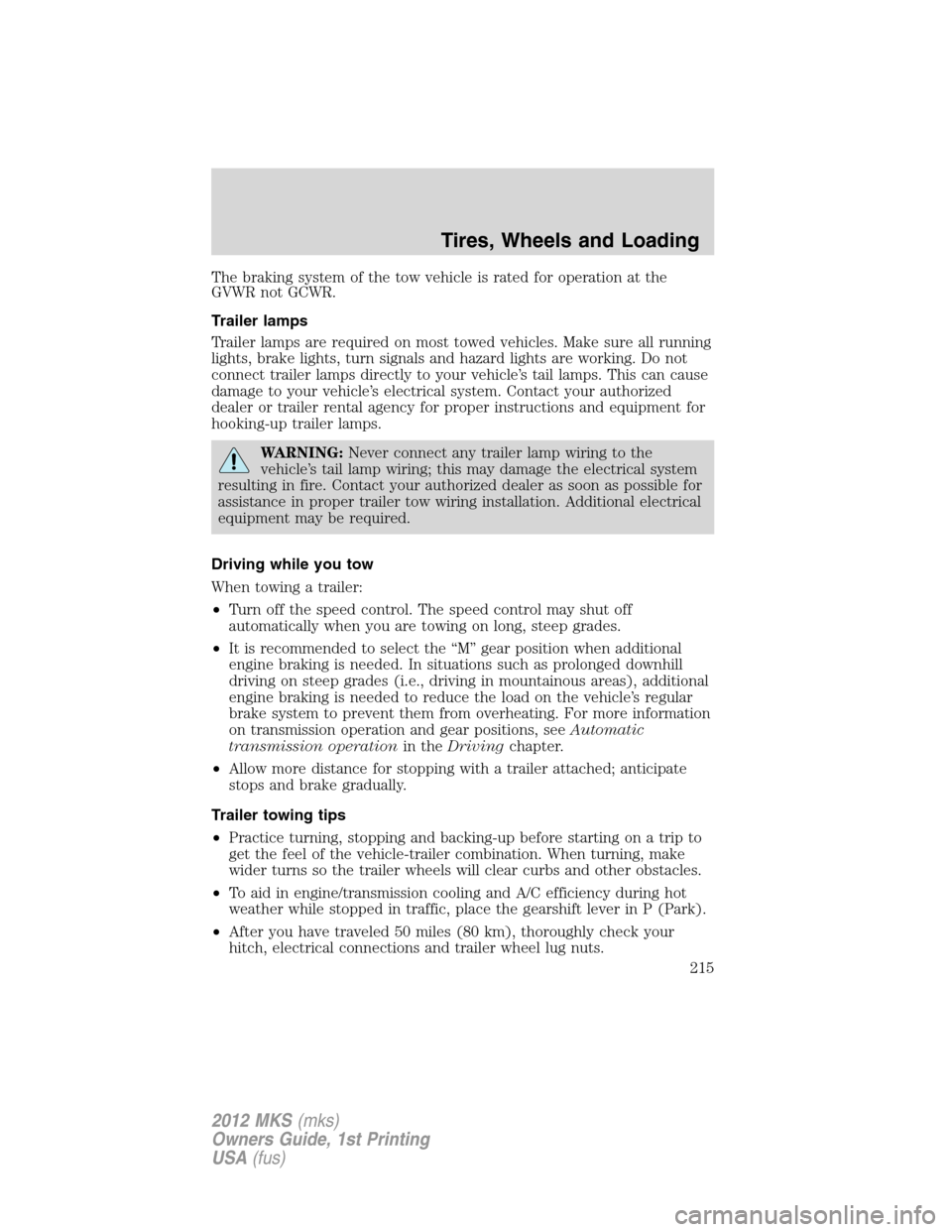
The braking system of the tow vehicle is rated for operation at the
GVWR not GCWR.
Trailer lamps
Trailer lamps are required on most towed vehicles. Make sure all running
lights, brake lights, turn signals and hazard lights are working. Do not
connect trailer lamps directly to your vehicle’s tail lamps. This can cause
damage to your vehicle’s electrical system. Contact your authorized
dealer or trailer rental agency for proper instructions and equipment for
hooking-up trailer lamps.
WARNING:Never connect any trailer lamp wiring to the
vehicle’s tail lamp wiring; this may damage the electrical system
resulting in fire. Contact your authorized dealer as soon as possible for
assistance in proper trailer tow wiring installation. Additional electrical
equipment may be required.
Driving while you tow
When towing a trailer:
•Turn off the speed control. The speed control may shut off
automatically when you are towing on long, steep grades.
•It is recommended to select the “M” gear position when additional
engine braking is needed. In situations such as prolonged downhill
driving on steep grades (i.e., driving in mountainous areas), additional
engine braking is needed to reduce the load on the vehicle’s regular
brake system to prevent them from overheating. For more information
on transmission operation and gear positions, seeAutomatic
transmission operationin theDrivingchapter.
•Allow more distance for stopping with a trailer attached; anticipate
stops and brake gradually.
Trailer towing tips
•Practice turning, stopping and backing-up before starting on a trip to
get the feel of the vehicle-trailer combination. When turning, make
wider turns so the trailer wheels will clear curbs and other obstacles.
•To aid in engine/transmission cooling and A/C efficiency during hot
weather while stopped in traffic, place the gearshift lever in P (Park).
•After you have traveled 50 miles (80 km), thoroughly check your
hitch, electrical connections and trailer wheel lug nuts.
Tires, Wheels and Loading
215
2012 MKS(mks)
Owners Guide, 1st Printing
USA(fus)
Page 259 of 384
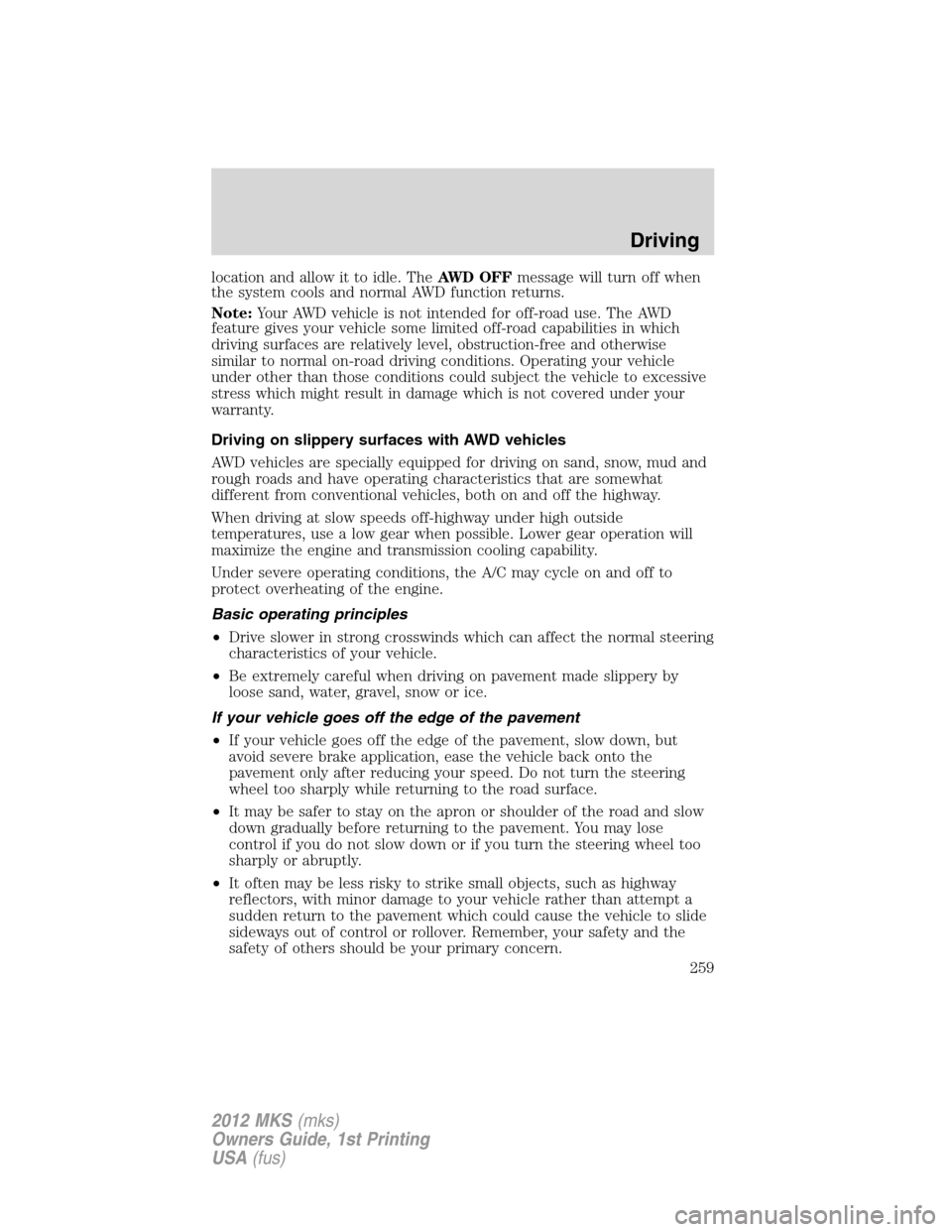
location and allow it to idle. TheAWD OFFmessage will turn off when
the system cools and normal AWD function returns.
Note:Your AWD vehicle is not intended for off-road use. The AWD
feature gives your vehicle some limited off-road capabilities in which
driving surfaces are relatively level, obstruction-free and otherwise
similar to normal on-road driving conditions. Operating your vehicle
under other than those conditions could subject the vehicle to excessive
stress which might result in damage which is not covered under your
warranty.
Driving on slippery surfaces with AWD vehicles
AWD vehicles are specially equipped for driving on sand, snow, mud and
rough roads and have operating characteristics that are somewhat
different from conventional vehicles, both on and off the highway.
When driving at slow speeds off-highway under high outside
temperatures, use a low gear when possible. Lower gear operation will
maximize the engine and transmission cooling capability.
Under severe operating conditions, the A/C may cycle on and off to
protect overheating of the engine.
Basic operating principles
•Drive slower in strong crosswinds which can affect the normal steering
characteristics of your vehicle.
•Be extremely careful when driving on pavement made slippery by
loose sand, water, gravel, snow or ice.
If your vehicle goes off the edge of the pavement
•If your vehicle goes off the edge of the pavement, slow down, but
avoid severe brake application, ease the vehicle back onto the
pavement only after reducing your speed. Do not turn the steering
wheel too sharply while returning to the road surface.
•It may be safer to stay on the apron or shoulder of the road and slow
down gradually before returning to the pavement. You may lose
control if you do not slow down or if you turn the steering wheel too
sharply or abruptly.
•It often may be less risky to strike small objects, such as highway
reflectors, with minor damage to your vehicle rather than attempt a
sudden return to the pavement which could cause the vehicle to slide
sideways out of control or rollover. Remember, your safety and the
safety of others should be your primary concern.
Driving
259
2012 MKS(mks)
Owners Guide, 1st Printing
USA(fus)
Page 261 of 384
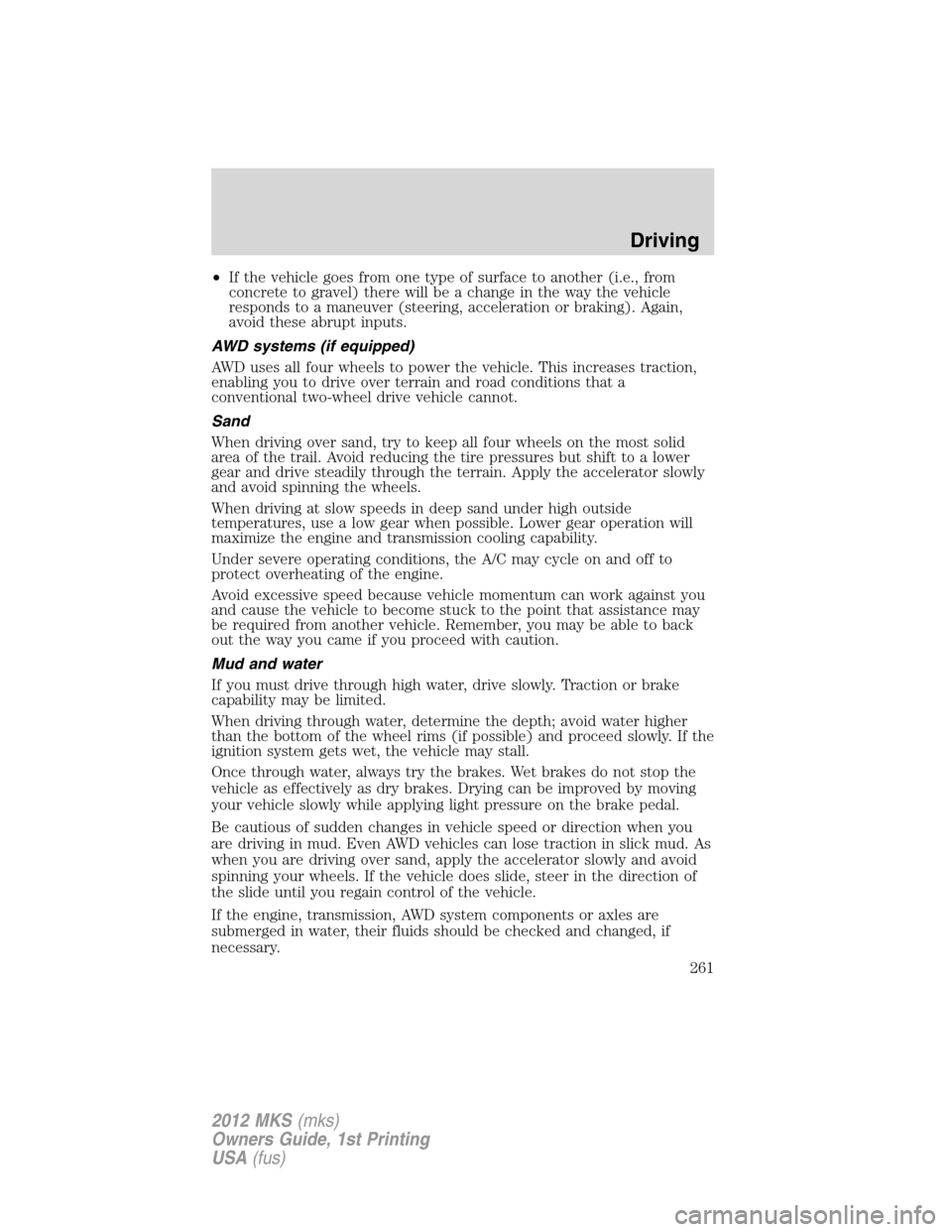
•If the vehicle goes from one type of surface to another (i.e., from
concrete to gravel) there will be a change in the way the vehicle
responds to a maneuver (steering, acceleration or braking). Again,
avoid these abrupt inputs.
AWD systems (if equipped)
AWD uses all four wheels to power the vehicle. This increases traction,
enabling you to drive over terrain and road conditions that a
conventional two-wheel drive vehicle cannot.
Sand
When driving over sand, try to keep all four wheels on the most solid
area of the trail. Avoid reducing the tire pressures but shift to a lower
gear and drive steadily through the terrain. Apply the accelerator slowly
and avoid spinning the wheels.
When driving at slow speeds in deep sand under high outside
temperatures, use a low gear when possible. Lower gear operation will
maximize the engine and transmission cooling capability.
Under severe operating conditions, the A/C may cycle on and off to
protect overheating of the engine.
Avoid excessive speed because vehicle momentum can work against you
and cause the vehicle to become stuck to the point that assistance may
be required from another vehicle. Remember, you may be able to back
out the way you came if you proceed with caution.
Mud and water
If you must drive through high water, drive slowly. Traction or brake
capability may be limited.
When driving through water, determine the depth; avoid water higher
than the bottom of the wheel rims (if possible) and proceed slowly. If the
ignition system gets wet, the vehicle may stall.
Once through water, always try the brakes. Wet brakes do not stop the
vehicle as effectively as dry brakes. Drying can be improved by moving
your vehicle slowly while applying light pressure on the brake pedal.
Be cautious of sudden changes in vehicle speed or direction when you
are driving in mud. Even AWD vehicles can lose traction in slick mud. As
when you are driving over sand, apply the accelerator slowly and avoid
spinning your wheels. If the vehicle does slide, steer in the direction of
the slide until you regain control of the vehicle.
If the engine, transmission, AWD system components or axles are
submerged in water, their fluids should be checked and changed, if
necessary.
Driving
261
2012 MKS(mks)
Owners Guide, 1st Printing
USA(fus)
Page 272 of 384
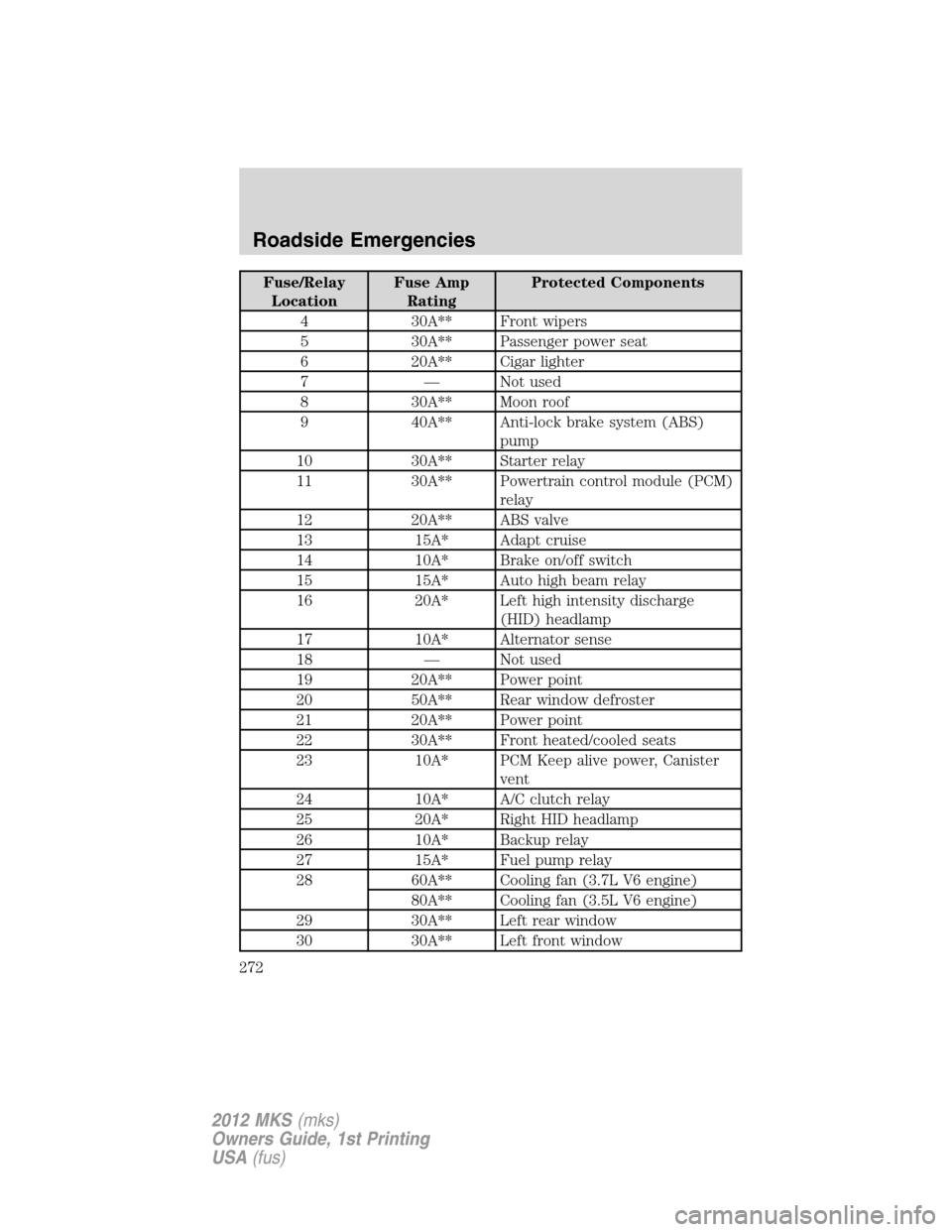
Fuse/Relay
LocationFuse Amp
RatingProtected Components
4 30A** Front wipers
5 30A** Passenger power seat
6 20A** Cigar lighter
7 — Not used
8 30A** Moon roof
9 40A** Anti-lock brake system (ABS)
pump
10 30A** Starter relay
11 30A** Powertrain control module (PCM)
relay
12 20A** ABS valve
13 15A* Adapt cruise
14 10A* Brake on/off switch
15 15A* Auto high beam relay
16 20A* Left high intensity discharge
(HID) headlamp
17 10A* Alternator sense
18 — Not used
19 20A** Power point
20 50A** Rear window defroster
21 20A** Power point
22 30A** Front heated/cooled seats
23 10A* PCM Keep alive power, Canister
vent
24 10A* A/C clutch relay
25 20A* Right HID headlamp
26 10A* Backup relay
27 15A* Fuel pump relay
28 60A** Cooling fan (3.7L V6 engine)
80A** Cooling fan (3.5L V6 engine)
29 30A** Left rear window
30 30A** Left front window
Roadside Emergencies
272
2012 MKS(mks)
Owners Guide, 1st Printing
USA(fus)